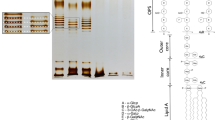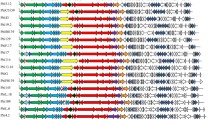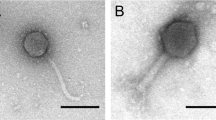Abstract
Lysins are phage-encoded, peptidoglycan (cell wall) hydrolases that accumulate in the bacterial cytoplasm during a lytic infection cycle. Late during infection, the lysins undergo holin-mediated translocation across the inner membrane into the peptidoglycan matrix where they cleave cell wall covalent bonds required for wall stability and allow bacterial lysis and progeny phage release. This potent hydrolytic activity is now the foundation of a powerful genetic-based screening process for the identification and analysis of phage lysin proteins. Here, we describe a method for identifying a lysin, PlyG, from a bacteriophage that specifically infects the Gram-positive organism Bacillus anthracis; however, the techniques described can be adapted to clone, express, and analyze lysins from any phage infecting Gram-positive bacteria or possibly even Gram-negative bacteria.
Access this chapter
Tax calculation will be finalised at checkout
Purchases are for personal use only
Similar content being viewed by others
References
Young, R., Bacteriophage lysis: Mechanism and regulation. Microbiol. Rev., 1992. 56(3): 430–481.
Brussow, H. and R.W. Hendrix, Phage genomics: Small is beautiful. Cell, 2002. 108): 13–16.
Loessner, M.J., et al., C-terminal domains of Listeria monocytogenes bacteriophage murein hydrolases determine specific recognition and high-affinity binding to bacterial cell wall carbohydrates. Molecular Microbiol., 2002. 44(2): 335–349.
Fischetti, V.A., Bacteriophage lytic enzymes: novel anti-infectives. Trends Microbiol, 2005. 13(10): 491–496.
Guzman, L.M., et al., Tight regulation, modulation, and high-level expression by vectors containing the arabinose \(P_{BAD}\) promoter. J. Bacteriol., 1995. 177): 4121–4130.
Loessner, M.J., et al., Three Bacillus cereus bacteriophage endolysins are unrelated but reveal high homology to cell wall hydrolases from different bacilli. J. Bacteriol., 1997. 179(9): 2845–2851.
Schuch, R., D. Nelson, and V.A. Fischetti, A bacteriolytic agent that detects and kills Bacillus anthracis. Nature, 2002. 418): 884–889.
Fischetti, V.A., E.C. Gotschlich, and A.W. Bernheimer, Purification and physical properties of group C streptococcal phage-associated lysin. J. Exp. Med., 1971. 133(5): 1105–1117.
Nelson, D., L. Loomis, and V.A. Fischetti, Prevention and elimination of upper respiratory colonization of mice by group A streptococci using a bacteriophage lytic enzyme. Proc. Natl. Acad. Sci. U.S.A., 2001. 98): 4107–4112.
Yoong, P., et al., Identification of a broadly active phage lytic enzyme with lethal activity against antibiotic-resistant Enterococcus faecalis and Enterococcus faecium. J. Bacteriol., 2004. 186): 4808–4812.
Cheng, Q., et al., Removal of group B streptococci colonizing the vagina and oropharynx of mice with a bacteriophage lytic enzyme. Antimicrob. Agents Chemother., 2005. 49): 111–117.
Loeffler, J.M., D. Nelson, and V.A. Fischetti, Rapid killing of Streptococcus pneumoniae with a bacteriophage cell wall hydrolase. Science, 2001. 294): 2170–2172.
Loessner, M.J., et al., Complete nucleotide sequence, molecular analysis and genome structure of bacteriophage A118 of Listeria monocytogenes: Implications for phage evolution. Molec. Microbiol., 2000. 35(2): 324–340.
Bateman, A. and N.D. Rawlings, The CHAP domain: a large family of amidases including GSP amidase and peptidoglycan hydrolases. Trends Biochem. Sci., 2003. 28): 234–237.
Author information
Authors and Affiliations
Editor information
Editors and Affiliations
Rights and permissions
Copyright information
© 2009 Humana Press, a part of Springer Science+Business Media, LLC
About this protocol
Cite this protocol
Schuch, R., Fischetti, V.A., Nelson, D.C. (2009). A Genetic Screen to Identify Bacteriophage Lysins. In: Clokie, M.R., Kropinski, A.M. (eds) Bacteriophages. Methods in Molecular Biology™, vol 502. Humana Press. https://doi.org/10.1007/978-1-60327-565-1_18
Download citation
DOI: https://doi.org/10.1007/978-1-60327-565-1_18
Publisher Name: Humana Press
Print ISBN: 978-1-60327-564-4
Online ISBN: 978-1-60327-565-1
eBook Packages: Springer Protocols




